Experimental and Finite Element Study on the Shear Performance of Existing Super-Span Concrete T-Beams Retrofitted with Glass Fiber-Reinforced Plastic
Abstract
:1. Introduction
2. Experimental Research
2.1. Detail of Specimen
2.2. Experimental Setup
2.3. Experimental Process
2.4. Analysis of Experimental Results
2.4.1. Load–Displacement Curve
2.4.2. Distribution of Shear Strain
3. Finite Element Analysis (FEA)
3.1. Establishing an FEA Model
3.2. Model Verification
3.2.1. Ultimate State of the Specimen
3.2.2. Load–Displacement Curve
3.3. Analysis of Inner Steel Bars
3.4. Influence Analysis of Loading Mode
3.4.1. The Influence on the Ultimate State
3.4.2. The Influence on Shear Bearing Capacity
3.4.3. The Influence of Strain Distribution on the Web
3.4.4. The Influence on the Strain of the Inner Steel Bar
4. Conclusions
- (1)
- Under shear loading, the failure process of the super-span T-beam strengthened by GFRP began with small cracks at the bottom of the mid-span web rather than at the bottom of the loading point.
- (2)
- The GFRP strips were effective in restraining the extension and connection of cracks in the initial stage. With an increase in load, multitudinous cracks gradually form an umbrella network. The diagonal cracks perpendicular to the GFRP strips appear earlier than the cracks parallel to or in the same direction as these strips.
- (3)
- For super-span concrete T-beams, the strain distribution in the web is complex. The shear strain of the two sides of the web is nearly symmetrically distributed. The strain of the web is distributed larger from the upper to the button.
- (4)
- Finite element analysis was especially significant for assessing an existing old concrete T-beam since the absence of information about its inner steel bars. The numerical analysis shows that the yielding of diagonally bent longitudinal steel bars, below the loading point, occurs earlier than that in other bars and maintained a larger strain at all times.
- (5)
- Since the regular double-point loading mode is invalid, finite element analysis is also significant for large-span beams subjected to shear load. Compared to the regular loading mode, the specimen tested using a single-point loading pattern has a slightly larger bearing capacity, and larger strain on the diagonal line of the web. In the former pattern, the largest strain on the inner steel bars appears in the bent section of the longitudinal bar and appears at the junction of the bent section in the latter pattern.
Author Contributions
Funding
Institutional Review Board Statement
Informed Consent Statement
Data Availability Statement
Conflicts of Interest
References
- Kotsovou, G.M.; Demitrios, M.C. Shear failure criterion for RC T-beams. Eng. Struct. 2018, 160, 44–55. [Google Scholar] [CrossRef]
- Jian, L.; Ziyue, G. A comparative study of models for shear strength of reinforced concrete T-beams. Structures 2022, 35, 922–930. [Google Scholar] [CrossRef]
- Jabbar, A.M.; Hamood, M.J.; Mohammed, D.H. The effect of using basalt fibers compared to steel fibers on the shear behavior of ultra-high performance concrete T-beam. Case Stud. Constr. Mat. 2021, 15, e00702. [Google Scholar] [CrossRef]
- Ayensa, A.; Oller, E.; Beltrán, B.; Ibarz, E.; Marí, A.; Gracia, L. Influence of the flanges width and thickness on the shear strength of reinforced concrete beams with T-shaped cross section. Eng. Struct. 2019, 188, 506–518. [Google Scholar] [CrossRef]
- Cladera, A.; Marí, A.; Ribas, C.; Bairán, J.; Oller, E. Predicting the shear–flexural strength of slender reinforced concrete T and I shaped beams. Eng. Struct. 2015, 101, 386–398. [Google Scholar] [CrossRef]
- Bousselham, A.; Chaallal, O. Shear strengthening reinforced concrete beams with fiber-reinforced ploymer: Assessment of influencing parameters and required research. Aci. Struct. 2004, 101, 219–227. [Google Scholar]
- Chen, J.; Teng, J. Shear capacity of fiber-reinforced polymer strengthened reinforced concrete beams: Fiber reinforced polymer rupture. J. Struct. Eng. 2003, 129, 615–625. [Google Scholar] [CrossRef]
- Bousselham, A.; Chaallal, O. Behavior of reinforced concrete T-beams strengthened in shear with carbon fiber-reinforced polymer-an experimental study. Aci. Struct. 2006, 103, 339–347. [Google Scholar]
- Foster, R.M.; Brindley, M.; Lees, J.M.; Ibell, T.J.; Morley, C.T.; Darby, A.P.; Evernden, M.C. Experimental investigation of reinforced concrete T-beams strengthened in shear with externally bonded CFRP sheets. J. Compos. Constr. 2017, 21, 04016086. [Google Scholar] [CrossRef]
- Khalifa, A.; Nanni, A. Improveing shear capacity of existing RC T-section beams using CFRP composites. J. Cem. Concr. Compos. 2000, 22, 165–174. [Google Scholar] [CrossRef]
- Kar, S.; Biswal, K.G. FRP shear contribution prediction for U-wrapped RC T-beams using a soft computing tool. Structures 2020, 27, 1093–1104. [Google Scholar] [CrossRef]
- Nie, X.; Zhang, S.; Teng, J.; Chen, G. Experimental study on RC T-section beams with an FRP-strengthened web opening. Compos. Struct. 2018, 185, 273–285. [Google Scholar] [CrossRef]
- Belarbi, A.; Bae, S.; Brancaccio, A. Behavior of full-scale RC T-beams strengthened in shear with externally bonded FRP sheets. Constr. Build Mater. 2012, 32, 27–40. [Google Scholar] [CrossRef]
- Nayak, C.B.; Narule, G.N.; Surwase, H.R. Structural and cracking behaviour of rc t-beams strengthened with bfrp sheets by experimental and analytical investigation. J. King Saud Univ. Eng. Sci. 2021, 34, 398–405. [Google Scholar] [CrossRef]
- Lee, H.; Cheong, S.; Ha, S.; Lee, C. Behavior and performance of RC-section deep beams externally strengthened in shear with CFRP sheets. Compos. Struct. 2011, 93, 911–922. [Google Scholar] [CrossRef]
- Mhanna, H.H.; Hawileh, R.A.; Abdalla, J.A. Shear behavior of RC T-beams externally strengthened with anchored high modulus carbon fiber-reinforced polymer (CFRP) laminates. Compos. Struct. 2021, 272, 114198. [Google Scholar] [CrossRef]
- Chen, J.; Teng, J. Shear capacity of FRP-strengthened RC beams: FRP debonding. Constr. Build Mater. 2003, 17, 27–41. [Google Scholar] [CrossRef]
- Hassan, A.; Baraghith, A.T.; Atta, A.M.; El-Shafiey, T.F. Retrofitting of shear-damaged RC T-beams using U-shaped SHCC jacket. Eng. Struct. 2021, 245, 112892. [Google Scholar] [CrossRef]
- Arslan, M.H.; Yazman, Ş; Hamad, A.A.; Aksoylu, C.; Özkılıç, Y.O.; Gemi, L. Shear strengthening of reinforced concrete T-beams with anchored and non-anchored CFRP fabrics. Structures 2022, 39, 527–542. [Google Scholar] [CrossRef]
- Cui, S.; Wang, J.; Shi, L.; Liu, Y. Test and FEM analysis of debonding failure of RC beam strengthened with CFRP. J. Reinf. Plast. Compos. 2009, 28, 2151–2160. [Google Scholar] [CrossRef]
- Chen, G.M.; Chen, J.F.; Teng, J.G. On the finite element modelling of RC beams shear-strengthened with FRP. Constr. Build Mater. 2012, 32, 13–26. [Google Scholar] [CrossRef]
- Tahenni, T.; Bouziadi, F.; Boulekbache, B.; Amziane, S. Experimental and nonlinear finite element analysis of shear behaviour of reinforced concrete beams. Structures 2021, 29, 1582–1596. [Google Scholar] [CrossRef]
- Demir, A.; Caglar, N.; Ozturk, H.; Sumer, Y. Nonlinear finite element study on the improvement of shear capacity in reinforced concrete T-Section beams by an alternative diagonal shear reinforcement. Eng. Struct. 2016, 120, 158–165. [Google Scholar] [CrossRef]
- Schanck, A.P.; Davids, W.G. Capacity assessment of older t-beam bridges by nonlinear proxy finite-element analysis. Structures 2020, 23, 267–278. [Google Scholar] [CrossRef]
- Lubliner, J.; Oliver, J.; Oller, S.; Oñate, E. A plastic-damage model for concrete. Solids Struct. 1989, 25, 299–326. [Google Scholar] [CrossRef]
- GB50010-2010; Chinese Code for Design of Concrete Structures. Ministry of Housing and Urban-Rural Development of the People’s Republic of China (MOHURD): Beijing, China, 2015.
- Mark, P.; Birtel, V. Parameterised finite element modelling of RC beam shear failure. In Proceedings of the 2006 ABAQUS Users’ Conference, Cambridge, MA, USA, 23–25 May 2006; pp. 95–108. [Google Scholar]
- Gotame, M.; Franklin, C.L.; Blomfors, M.; Yang, J.; Lundgren, K. Finite element analyses of FRP-strengthened concrete beams with corroded reinforcement. Eng. Struct. 2022, 257, 11407. [Google Scholar] [CrossRef]
- GB/T 50152-2012; Standard for Test Method of Concrete Structures. Ministry of Housing and Urban-Rural Development of the People’s Republic of China (MOHURD): Beijing, China, 2012.

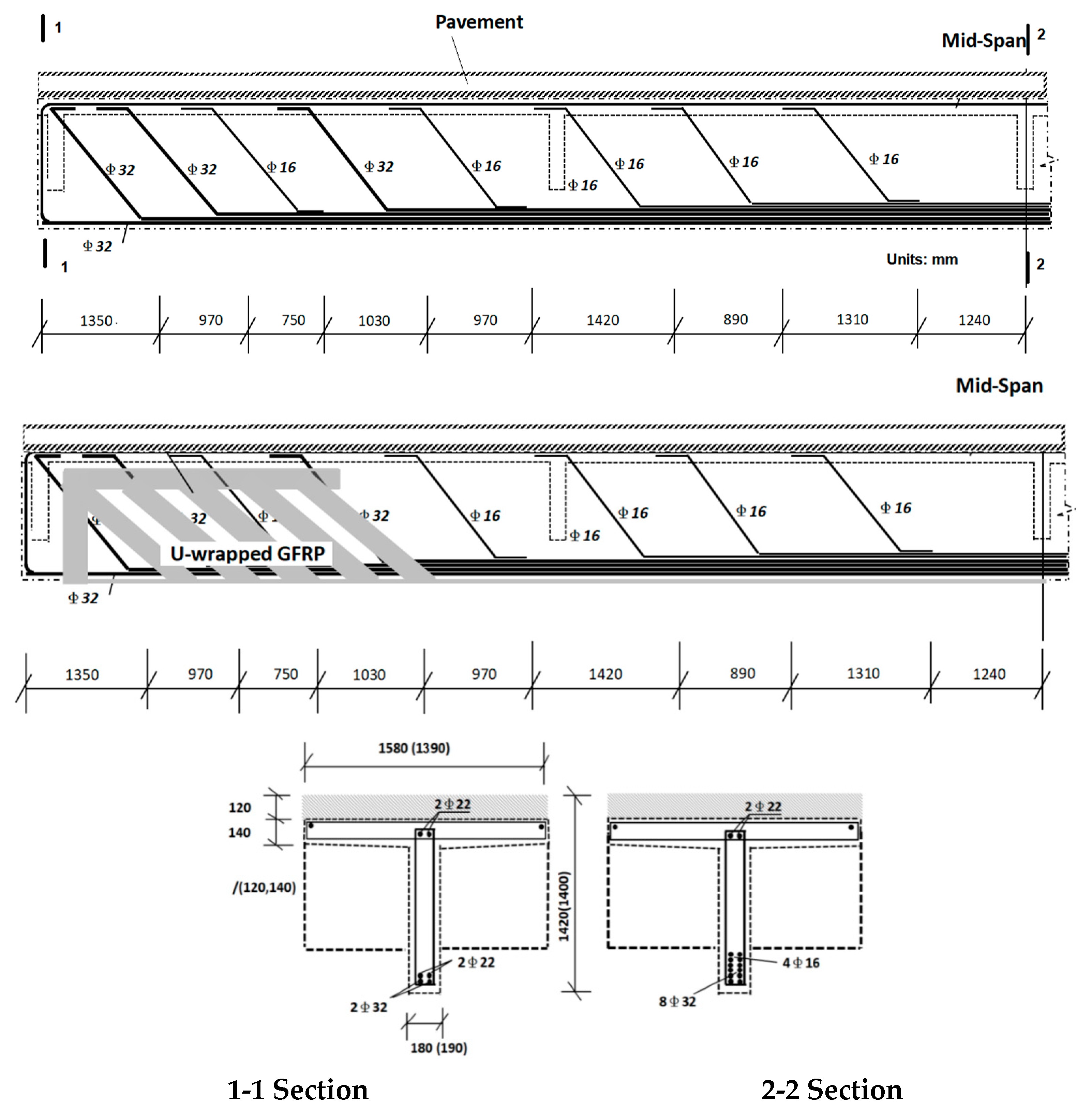
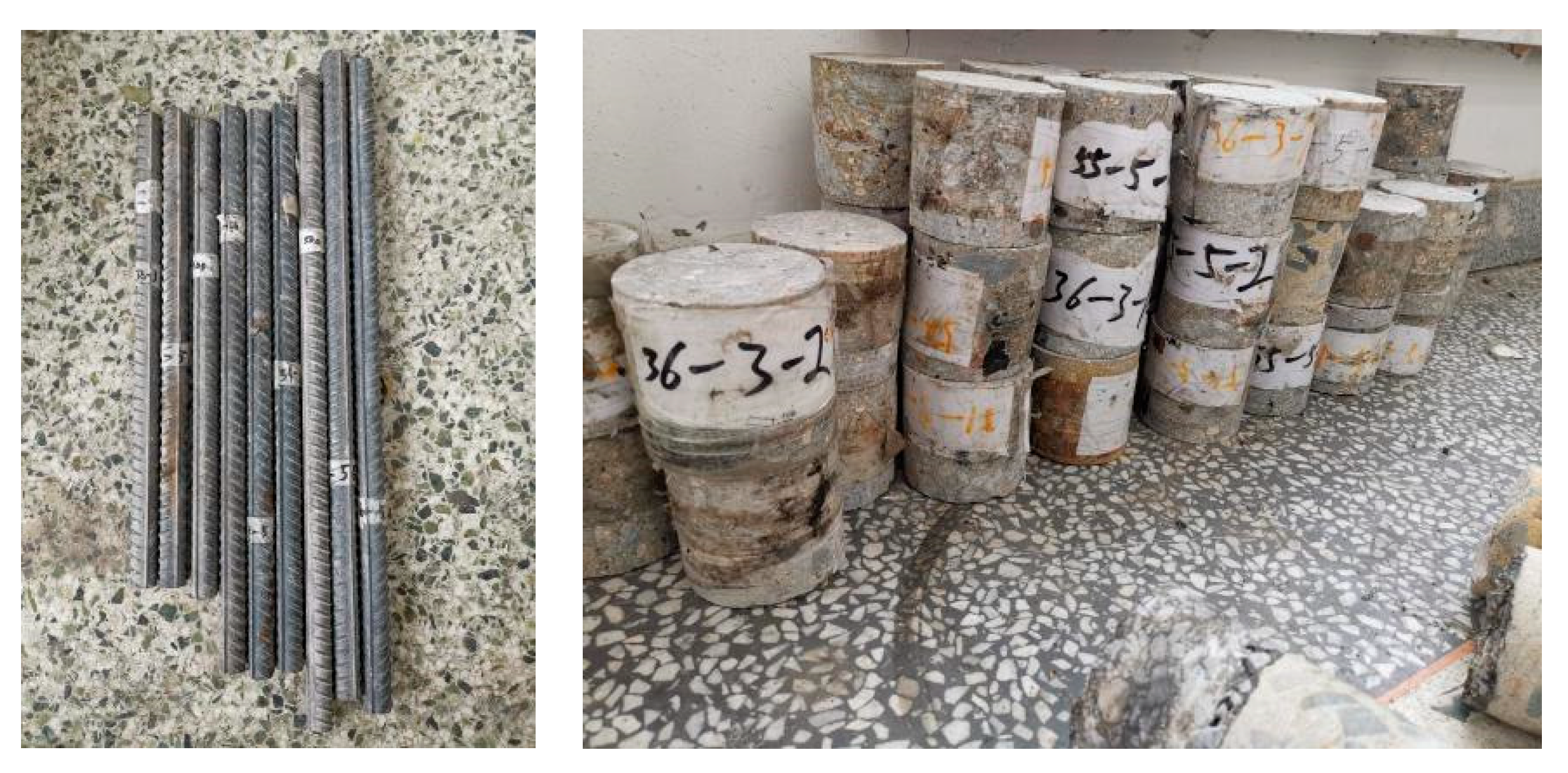


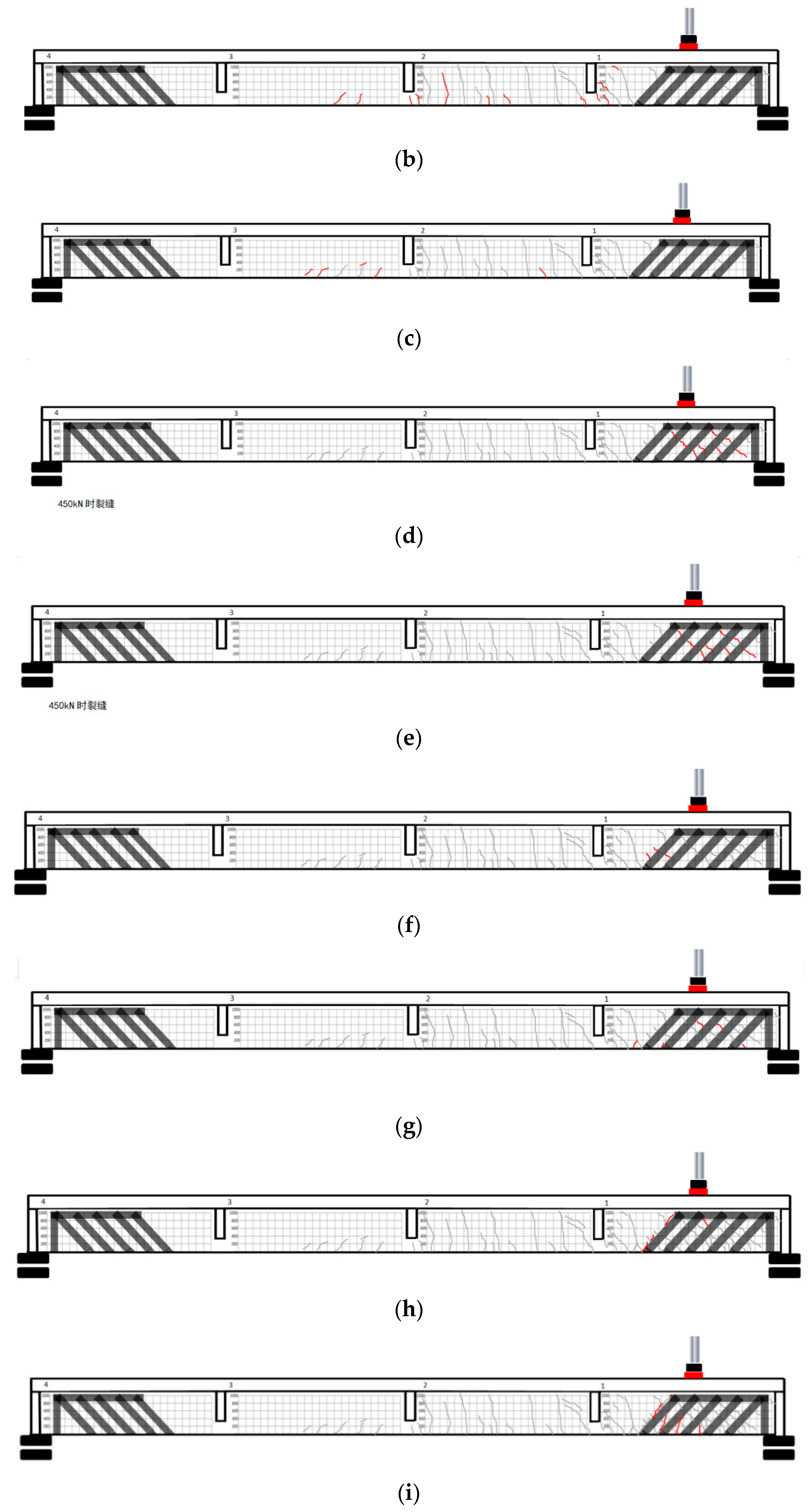

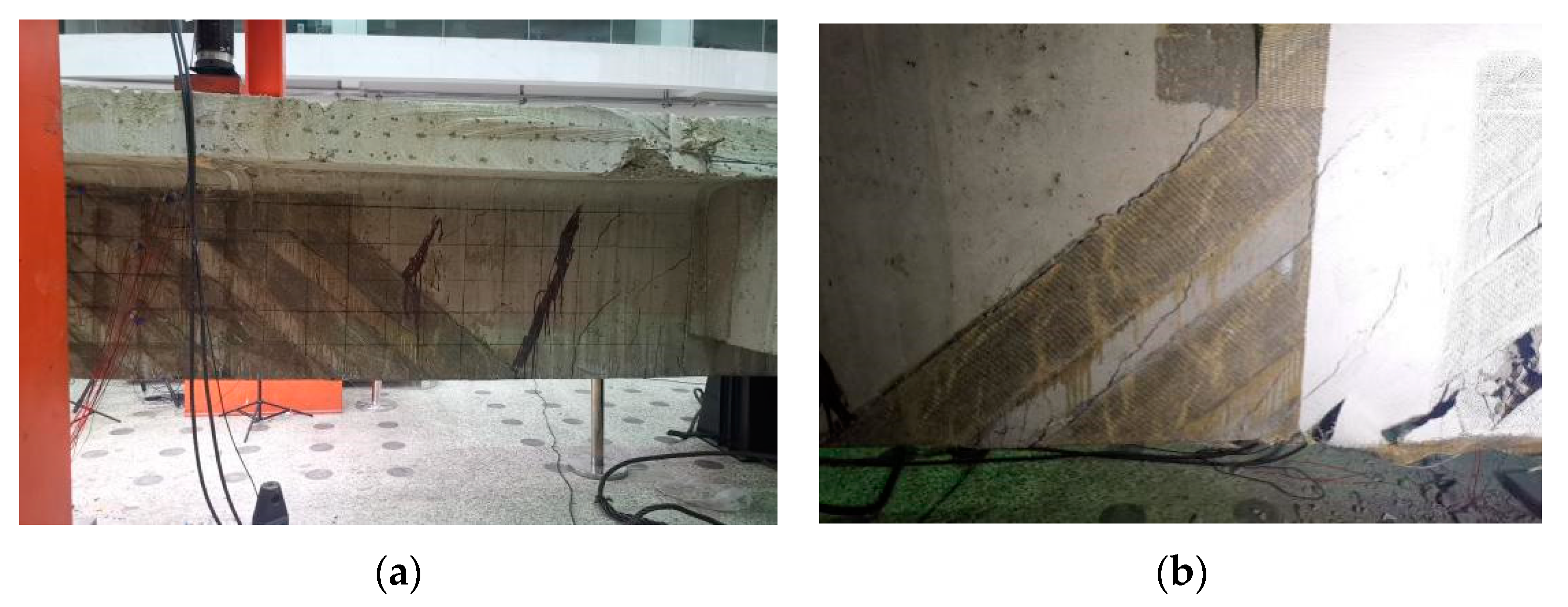
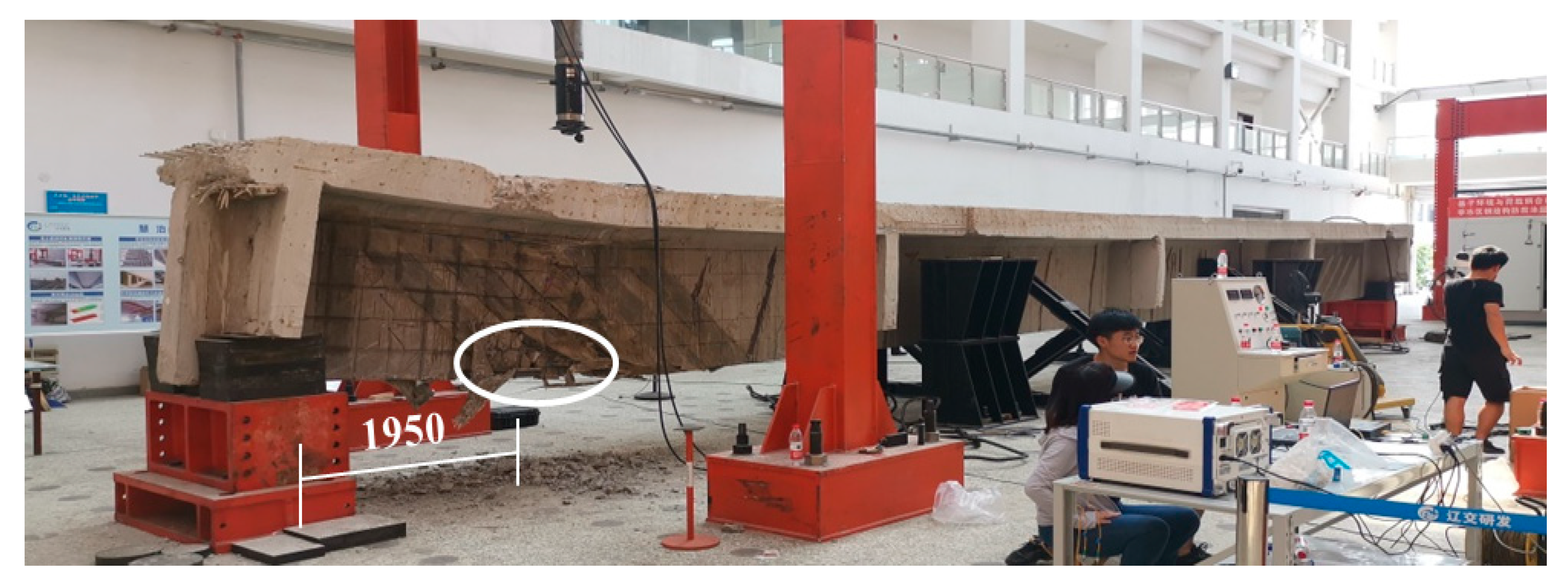


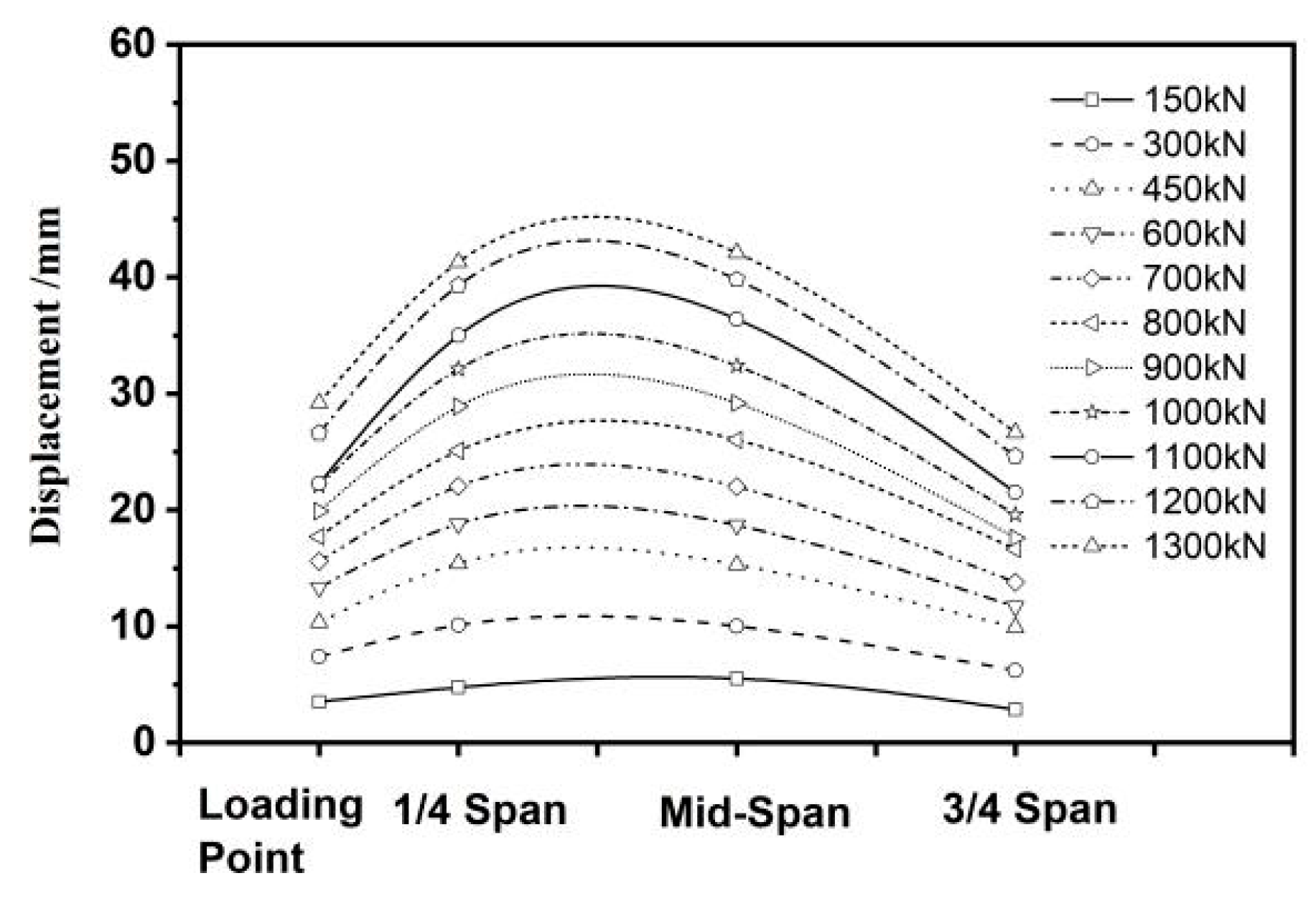
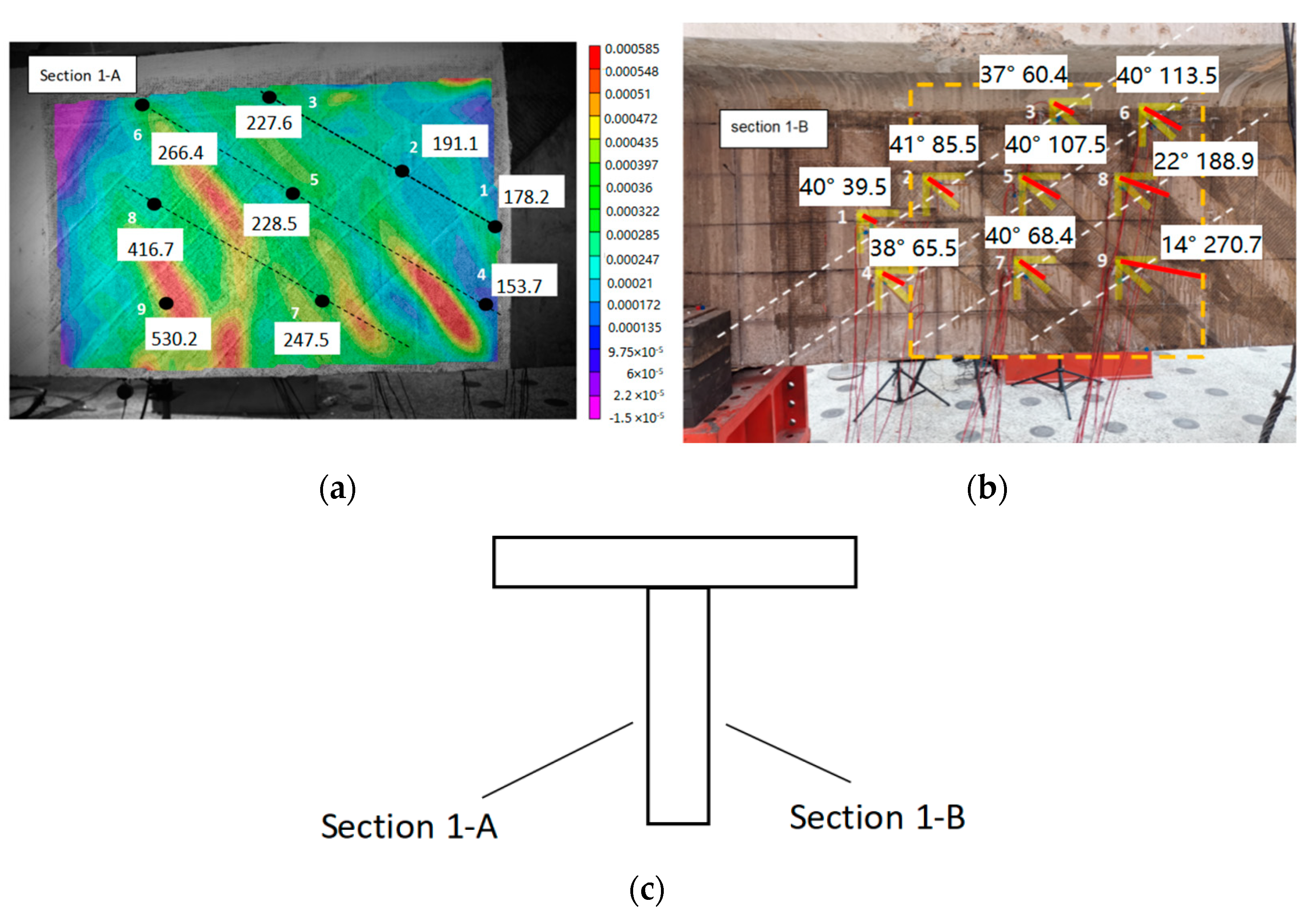
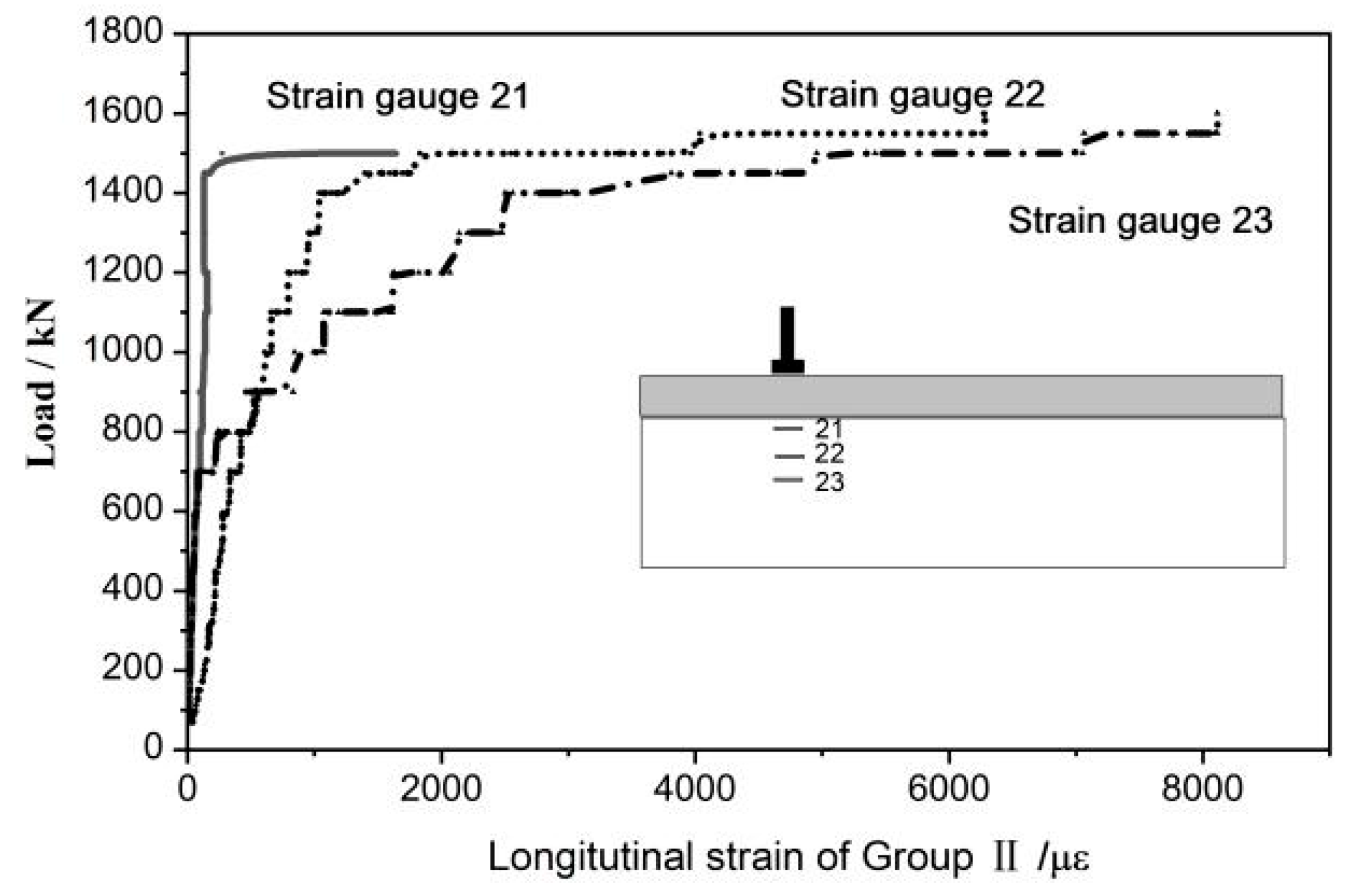



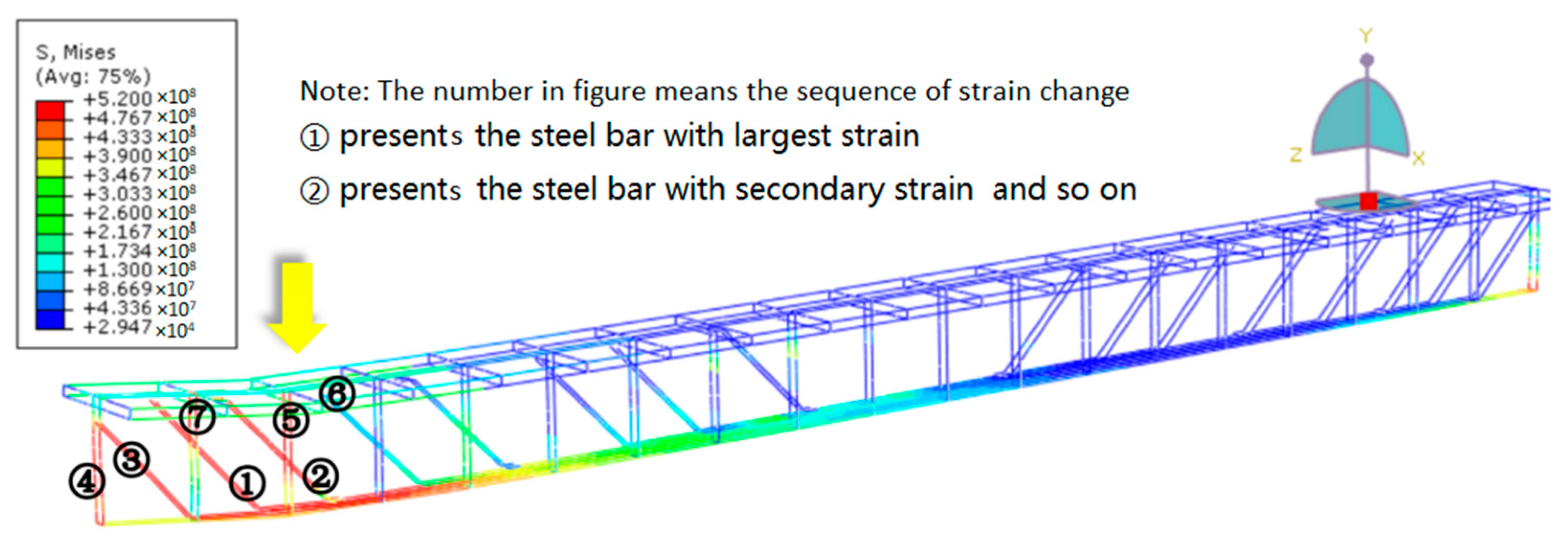

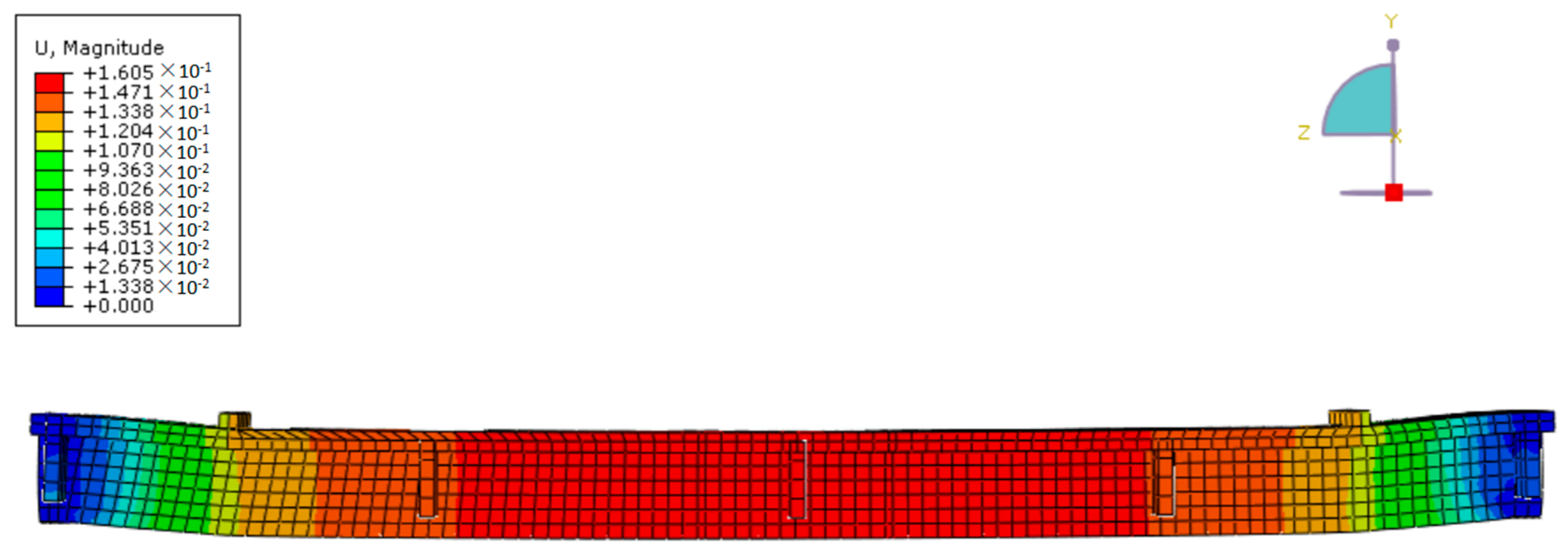
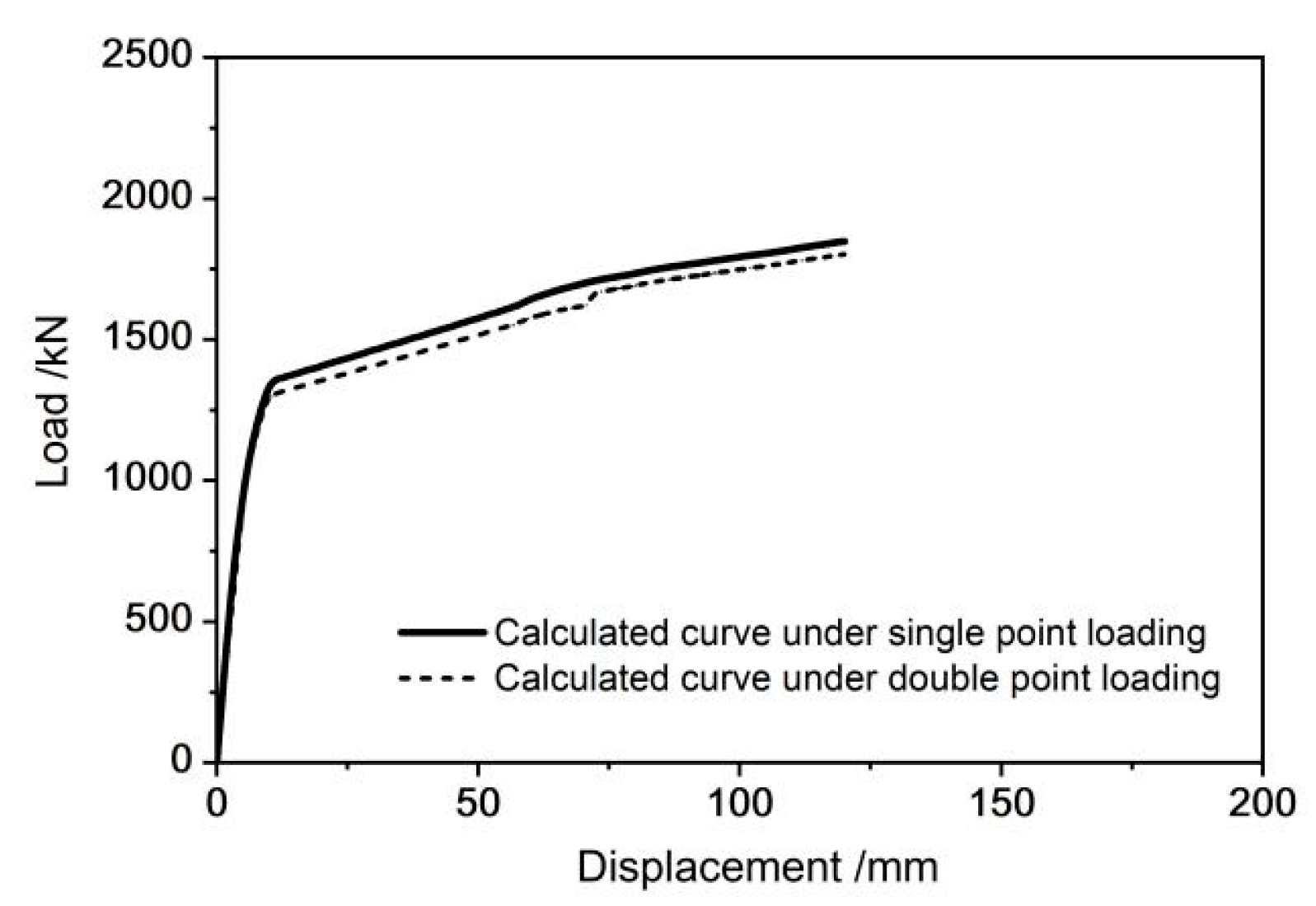

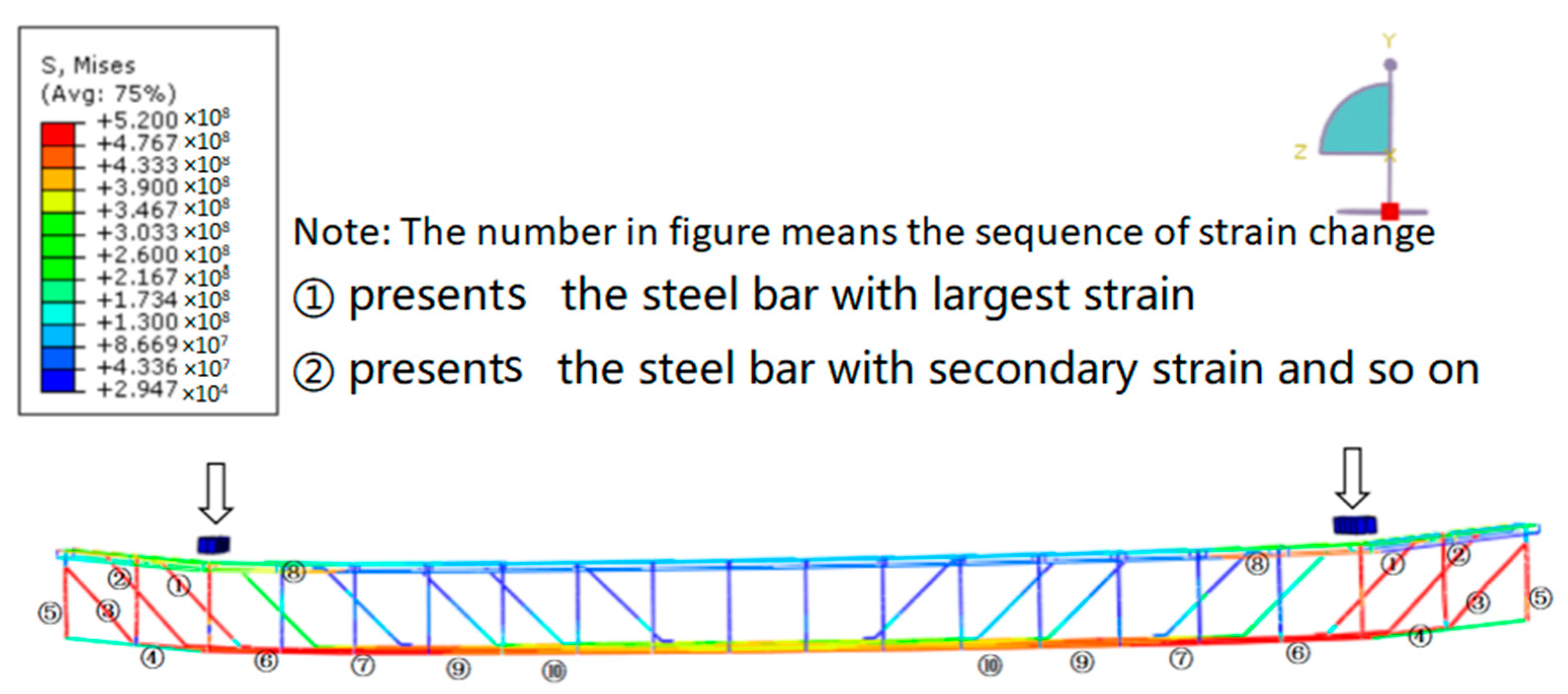
| fcb/MPa | fcp/MPa | fy/MPa | fu/MPa | Es/GPa | fGFRP/MPa | EGFRP/GPa | |
|---|---|---|---|---|---|---|---|
| Nominal value | 23 | 40 | 360 | 580 | 200 | 800 | 80 |
| Measured value | 31.2 | 45.9 | 320.7 | 521.2 | 215.2 | _ | _ |
Disclaimer/Publisher’s Note: The statements, opinions and data contained in all publications are solely those of the individual author(s) and contributor(s) and not of MDPI and/or the editor(s). MDPI and/or the editor(s) disclaim responsibility for any injury to people or property resulting from any ideas, methods, instructions or products referred to in the content. |
© 2023 by the authors. Licensee MDPI, Basel, Switzerland. This article is an open access article distributed under the terms and conditions of the Creative Commons Attribution (CC BY) license (https://creativecommons.org/licenses/by/4.0/).
Share and Cite
Hou, D.; Hu, T.; Zhang, G. Experimental and Finite Element Study on the Shear Performance of Existing Super-Span Concrete T-Beams Retrofitted with Glass Fiber-Reinforced Plastic. Sustainability 2023, 15, 2768. https://doi.org/10.3390/su15032768
Hou D, Hu T, Zhang G. Experimental and Finite Element Study on the Shear Performance of Existing Super-Span Concrete T-Beams Retrofitted with Glass Fiber-Reinforced Plastic. Sustainability. 2023; 15(3):2768. https://doi.org/10.3390/su15032768
Chicago/Turabian StyleHou, Dongxu, Tieming Hu, and Guanhua Zhang. 2023. "Experimental and Finite Element Study on the Shear Performance of Existing Super-Span Concrete T-Beams Retrofitted with Glass Fiber-Reinforced Plastic" Sustainability 15, no. 3: 2768. https://doi.org/10.3390/su15032768
APA StyleHou, D., Hu, T., & Zhang, G. (2023). Experimental and Finite Element Study on the Shear Performance of Existing Super-Span Concrete T-Beams Retrofitted with Glass Fiber-Reinforced Plastic. Sustainability, 15(3), 2768. https://doi.org/10.3390/su15032768








